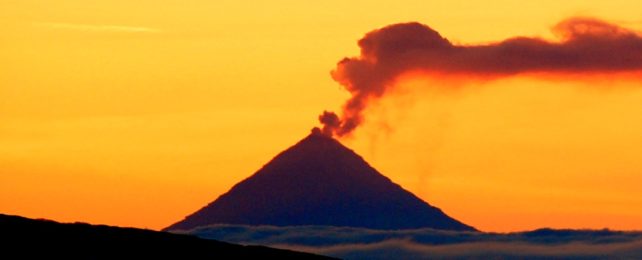Even if humanity manages not to self-destruct with war or climate change, there are still other existential threats we must be ready for.
Earth came pre-loaded with plenty of dangers long before we began piling on, some of which our species has still barely experienced.
One of the flashier dangers comes from asteroids, like the one suspected of devastating the dinosaurs 65 million years ago. As we try to anticipate our own doomsday, the cautionary tale of dinosaurs seems to suggest we direct our vigilance upward.
That makes sense, and humans are wisely preparing in ways the dinosaurs couldn't, with investments in asteroid monitoring and even deflection.
But as two researchers point out in a new commentary in the journal Nature, we shouldn't let asteroid anxiety overshadow another colossal danger lurking under our noses: volcanoes.
"Over the next century, large-scale volcanic eruptions are hundreds of times more likely to occur than are asteroid and comet impacts, put together," write Michael Cassidy, a professor of volcanology at the University of Birmingham, and Lara Mani, a research associate at the Centre for the Study of Existential Risk at the University of Cambridge.
While preparing for asteroids is prudent, we're doing too little about the likelier event of a volcanic "super-eruption", Cassidy and Mani argue.
Governments and global agencies spend hundreds of millions of dollars annually on planetary defense, they write, including a new US experiment to fend off space rocks.
NASA's Double Asteroid Redirection Test (DART) mission will soon test the feasibility of asteroid deflection by trying to move an asteroid off course. The DART mission will cost about $330 million, and while that's a bargain if it saves us from an asteroid, Cassidy and Mani note there is no comparable investment to prep for a super-eruption.
"This needs to change," they write.
Volcanoes may be less exotic than fireballs from space, but that's all the more reason to respect them: Volcanoes, unlike asteroids, are already here on Earth. They're scattered all over the planet, often blanketed with picturesque scenery that belies their destructive potential.
And while humans have seen lots of terrible eruptions in modern times, most pale in comparison to the supervolcanoes that erupt every 15,000 years or so.
The last super-eruption of this kind happened about 22,000 years ago, according to the US Geological Survey. (A "super-eruption" is one with a magnitude of 8, the highest rating on the Volcanic Explosivity Index, or VEI.)
The most recent magnitude-7 eruption occurred in 1815 at Mount Tambora, Indonesia, killing an estimated 100,000 people.
The ash and smoke reduced global temperatures by about 1 degree Celsius on average, causing the "Year Without a Summer" in 1816. There were widespread crop failures, leading to famine, disease outbreaks, and violence.
Volcano monitoring has improved since 1815, as has our ability to rally global support for disaster relief, but not necessarily enough to offset all the risks we now face.
Earth's human population has octupled since the early 1800s, Cassidy and Mani note, and some big urban areas have blossomed near dangerous volcanoes. We're more reliant on global trade, too, so upheaval in one place can spur food shortages and other crises elsewhere.
The peril posed by volcanoes may also be greater than we think. In a 2021 study based on data from ancient ice cores, researchers found the intervals between catastrophic eruptions are hundreds or even thousands of years shorter than previously believed.
The history of many volcanoes remains murky, making it hard to anticipate future eruptions and focus resources where risks are highest. We need more research on ice cores as well as historical and geological records, Cassidy and Mani write, including marine and lakes cores, especially in high-risk but data-poor regions like Southeast Asia.
We also need more interdisciplinary research to help us predict how a super-eruption might cripple civilization, they add, by identifying risks to trade, agriculture, energy, and infrastructure, plus geographic "pinch points" where volcanic risks overlap with critical trade networks.
More comprehensive volcano monitoring is vital, too, including ground-based monitoring as well as aerial and satellite observation. The researchers note volcanologists have long pined for a specialized volcano-observing satellite, which could boost preparedness beyond the current system of sharing existing satellites with other scientists.
Community awareness and education is another key to resilience. People need to know if they live in volcanic danger zones, how to prepare for an eruption, and what to do when it happens.
Beyond preparatory outreach, authorities also need ways to broadcast public alerts when volcanoes erupt, Cassidy and Mani write, like text messages with details about evacuations, tips for surviving an eruption, or directions to shelters and health-care facilities.
The commentary was published in the journal Nature.
